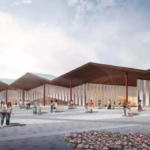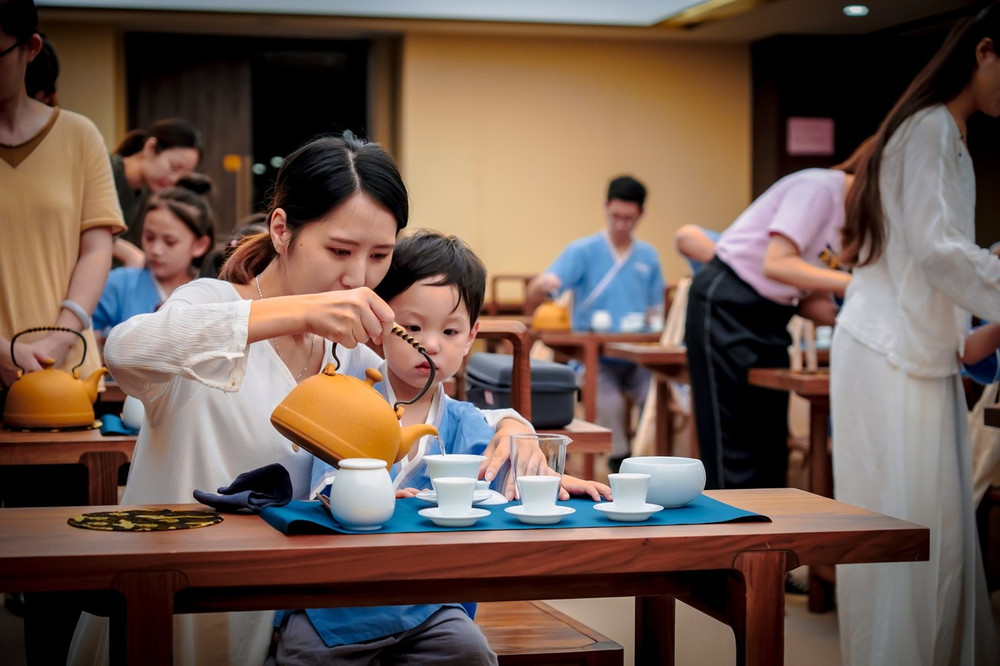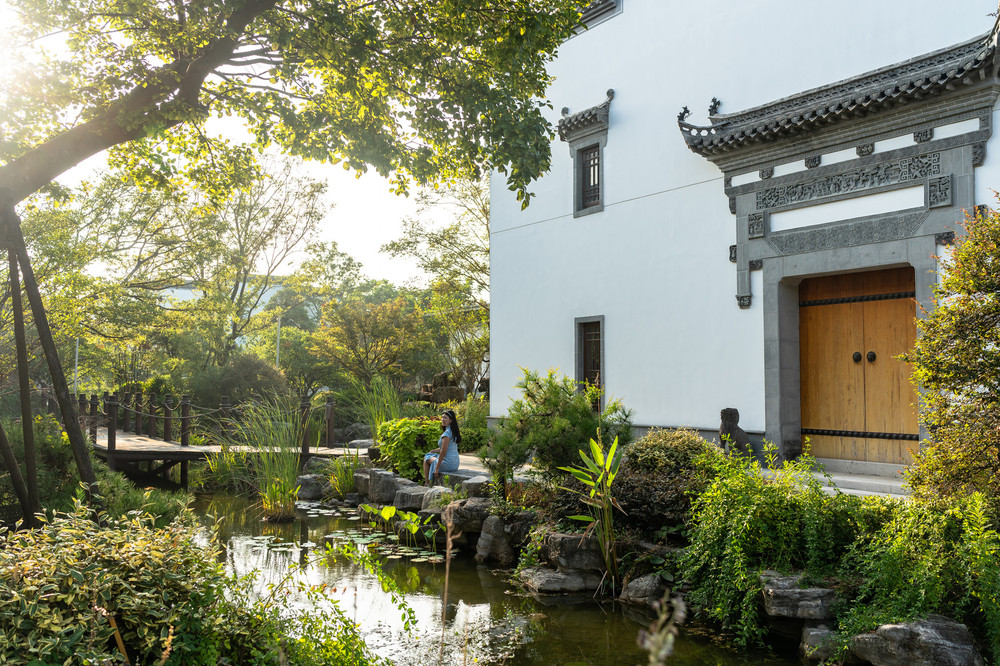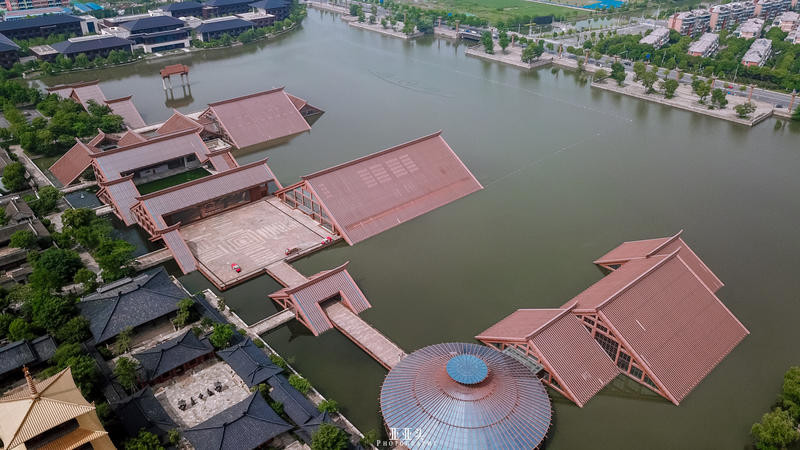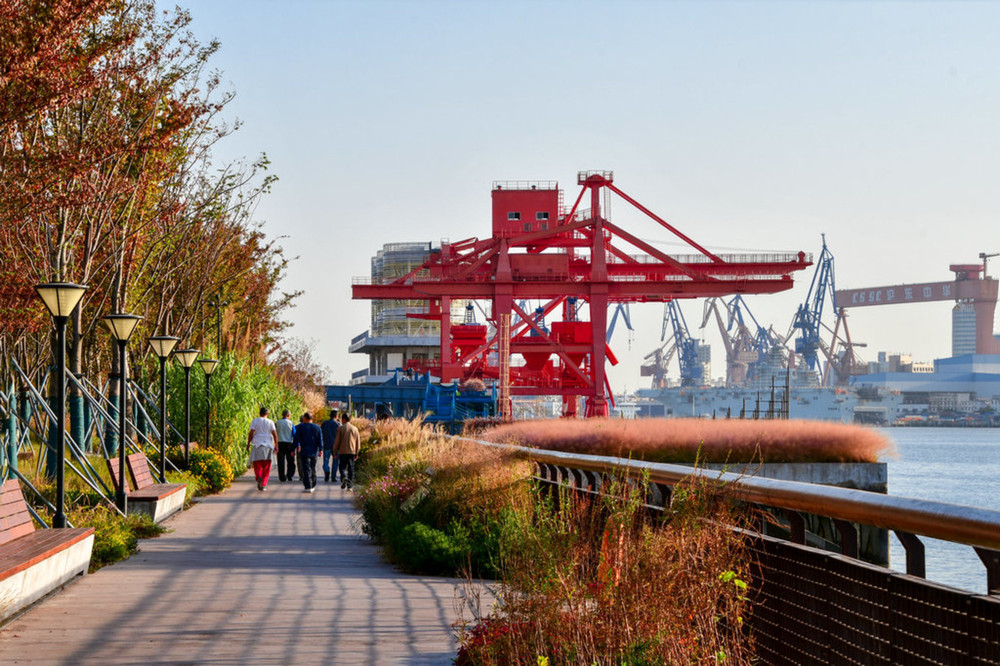Duration: 3 days. Time: November. Per capita cost: 2000 yuan. With whom: Friends.

The author visited these places: Tiger Hill and Tiger Hill Pagoda in Suzhou, Shuangjing Bridge, Humble Administrator’s Garden, Lingering Garden, North Temple Pagoda, Nanyuan, Suzhou Museum, Lion Grove, Deyuelou, Guanqian Street, Nanyuan Hotel, Former Residence of Jiang Weiguo, Master-of-Nets Garden, Hanshan Temple, Maple Bridge, Taihu Lake, Yangcheng Lake, Lianhua Island in Yangcheng Lake, Xishan in Yangcheng Lake. Posted on August 31, 2020, 12:36.
In a flash, it was November, and the autumn wind became colder. Without a long holiday, we went for a trip around on weekends. There is paradise in heaven and Suzhou and Hangzhou on earth. Targeting Suzhou, I invited Miss Ling. We hit it off immediately. Renting a car for a short-distance self-driving trip is also casual and relaxing.
Setting off early in the morning, although there was a small episode of refueling and changing the car, everything went smoothly. Miss Ling decided on having breakfast at Aozao Restaurant in Kunshan as the first stop. There was not too much traffic on the expressway. Only at the toll booth did we wait in line for a while. We arrived in Kunshan before the noon rush. Kunshan is no stranger to most people in Shanghai. Aozao Restaurant is located at Banshanqiao Yi, south gate of Tinglin (Gu Yanwu’s courtesy name is Tinglin) Park in Kunshan. It is the traditional noodle restaurant with the longest history in Kunshan. It is said that the owner of Aozao Noodles had poor eyesight in the past, and the noodles he made were a bit unclean. Old customers jokingly called it ‘Aozao Noodles’. ‘Aozao’ is a local dialect in Kunshan, meaning not very clean. Unexpectedly, this strange name made it spread quickly. The noodles are Suzhou-style noodles. The soup is fresh and the noodles are smooth. We directly ordered a four-topping noodles. The restaurant was crowded with people. It was delicious and also a small satisfaction.
After eating, we drove for dozens of kilometers directly to Suzhou. With the help of the navigator, our first stop was Tiger Hill. Miss Ling and the secretary had both been to Tiger Hill when they were young, but their memories had faded a bit. In the last century, for people in Shanghai, whether it was a family outing with children or sweeping tombs on Tomb-Sweeping Day, Suzhou was definitely the first choice. This time, coming to Tiger Hill, we wanted to see the Tiger Hill Pagoda and revisit the Sword-Trying Stone that still had a vague impression.
Tiger Hill is not large. Before entering the scenic area, the nearby roads have been surrounded by wedding dress shops. This is a famous wedding dress street. According to legend, King Helü of Wu was accidentally injured in the great battle of Zuili with the State of Yue and soon died. King Fuchai of Wu buried his father here. Three days after the burial, a white tiger crouched on it. Hence, this place is named ‘Tiger Hill’.
Passing through the archway of ‘The First Scenic Spot in Wuzhong’, the Tiger Hill Pagoda is already in sight. Crossing the small river at the entrance, one can enter the scenic area. It is said that this mountain is only 36 meters high. Entering the scenic area, there are free tour guides. The service in the south of the Yangtze River is still very in place. Moving forward all the way, there is a vague impression of childhood. Hanhan Well, Sword-Trying Stone. Looking and listening, it is quite comfortable. The Sword Pool in front of the Thousand People Stone is full of mystery. It is said that there are three thousand swords at the bottom of the pool. Ascending the steps and walking onto Shuangjing Bridge, looking at the Sword Pool under the bridge through the double wells on the bridge, one feels a bit dizzy. After crossing Shuangjing Bridge, one arrives at the core Tiger Hill Pagoda.
The Tiger Hill Pagoda, actually known as the Yunyan Temple Pagoda, exudes a somewhat dilapidated charm. It is a seven-story brick pagoda with an octagonal, wooden structure imitation design, and stands as the only multi-layered building in the Jiangnan region that dates back to the Five Dynasties period. Due to the foundation being half on sandy soil and half on rock, the pagoda’s apex tilts slightly to the north-east. It is said that the pagoda was already leaning towards the north-east before its completion, and after standing for a millennium,### The Humble Administrator’s Garden and Suzhou Museum Visit
#### A Smooth Entry into the Garden
The central urban area has extremely complex parking, but we managed to enter the garden smoothly. The off-season ticket price is 50 yuan, and there is a complimentary guided tour service.
#### A Historical Overview
Constructed in the fourth year of the Zhengde era during the Ming Dynasty, the Humble Administrator’s Garden is one of the four most famous gardens in China. Initially, it was the residence of the Tang Dynasty poet Lu Guimeng, then became the Dahong Temple during the Yuan Dynasty. In the Jiajing era of the Ming Dynasty, the imperial censor Wang Xianchen, after retiring from a disappointing political career, bought the garden and hired Wen Zhengming to participate in the design blueprint. It took 16 years to complete the garden.
#### A Tale of Ownership and Legacy
Shortly after its completion, Wang Xianchen passed away, and his son lost the entire garden in a single night of gambling to the Xu family, who were the owners of the Lingering Garden at the time. The current Humble Administrator’s Garden covers an area of 70 acres and, by the end of the Qing Dynasty, had formed three relatively independent smaller gardens: east, central, and west.
#### The Guided Tour Experience
As we walked and listened to the guide’s explanations, we passed through corridors and gardens, all exquisite and delicate. By the small lake, one can see the Suzhou North Temple Pagoda. The government has protected the ancient city of Suzhou by not allowing any buildings to exceed three levels higher than the North Temple Pagoda, which makes the entire city look very comfortable.
#### The Garden’s Architectural Charm
The eastern part of the garden, with its original Ming Dynasty design, feels more charming than the Qing Dynasty section. Walking through the complex corridors and observing the garden’s rockeries and ponds, it is difficult to describe the Jiangnan gardens in words. My feeling is that they complicate the simple courtyard, with no straight paths and no identical window patterns, creating a sense of interest and charm without appearing cluttered.
#### The Absence of Residential Quarters
After completing the tour, Miss Zero wondered why there was no residential area for the owners. The guide explained that ‘this is the garden area, and the residential area has been separated and is now the Suzhou Museum and the Taiping Prince’s Mansion’, which probably no longer retains its original appearance.
#### The Suzhou Museum
Fortunately, the most outstanding feature here is the garden itself, so much so that even emperors from the north have greatly admired the gardens here. There are numerous royal gardens in the imperial city that imitate and replicate the Jiangnan gardens. After leaving the Humble Administrator’s Garden, a 200-meter walk brought us to the Suzhou Museum.
#### The Architectural Marvel of the Museum
The exhibits here are not particularly eye-catching, but the museum itself is quite impressive, designed by I.M. Pei. It is said that I.M. Pei is from Suzhou and, as a member of a prominent local family, lived in the Lion Grove Garden for a period during his childhood. As one of the world’s most renowned architects, his design for the museum can be seen as a way of giving back to his hometown! Of course, it complements the gardens designed by Wen Zhengming, and perhaps only the elder Pei could have designed it.
#### The Fusion of Modern and Traditional
The Suzhou Museum continues to exude the traditional Suzhou charm with its white walls and black tiles, seamlessly blending modern elements with classical gardens. Its interior spaces and lighting are well-designed for comfort, leaving this layman to merely enjoy the spectacle.
#### The Zhongwang Mansion and Nan Yuan Hotel
After departing the museum and passing through the Zhongwang Mansion, I completed my visit to the Humble Administrator’s Garden. Navigating through the entire Suzhou urban area by car is an incredibly arduous experience; the city is riddled with small rivers, offering few straight paths across, and with government protection in place, there are almost no wide roads.
#### The Nan Yuan Hotel Experience
The decision to stay at the Nan Yuan Hotel was based on its unique offering of a Suzhou garden that can be inhabited. As the day had grown late, I planned to explore the hotel the next day and set off for dinner at Songhe Building.
#### Dining at Yue Lou
To my dismay, the Songhe Building was booked by wealthy patrons, leaving me to try my luck at the Yue Lou across the street. Despite its small facade, Yue Lou gained fame from a movie in the last century and has since become quite renowned. After a brief wait in line, I was seated amidst the backdrop of a wedding banquet and a birthday celebration. The interior was vast, so much so that one could easily get lost. The squirrel-shaped mandarin fish, sizzling eel in oil, and date paste cake were all exceptional dishes.
#### The Regret and the Wu Dialect
Unable to finish the meal, I took the leftovers, including the fish head, as the sauce was simply divine – slightly sour and sweet, with a non-greasy texture. The only regret was that the waitstaff and diners were mostly from other regions; I didn’t hear the soft and mellow Suzhou dialect but instead was surrounded by Shanghainese and Mandarin.
#### The Search for the Wu Dialect
After dinner, the only place to hear the gentle Wu dialect was on Guanqian Street, where two urban management officers were conversing.The next day, after a quiet night, I woke up early, had breakfast at the hotel, and began my tour of the Nan Yuan Hotel.
First, I visited the former residence of Chiang Wei-kuo. It is a three-story elegant building that is still available for guests. The top floor houses a single room which is presumably expensive.
Adjacent to the building is the site of Lin Biao’s Project 571. It is smaller than Hangzhou’s Project 704 but similar in nature. After exploring the underground passageways that lead to the vicinity of the swimming pool, I moved on to the Ming Xuan Garden, dubbed the ‘Little Master of the Nets Garden’. Despite its small size, the garden boasts artificial hills, a small lake, corridors, and pavilions. It is a quintessential Suzhou garden. The pavilion by the lake can accommodate a banquet. It is said to have been frequented by many officials and is known as the ‘First Banquet of Wu Style’.
After leaving Ming Xuan, I strolled around the hotel grounds and came across the Shanqing Zen Temple. It is a small temple that I casually visited, completing my tour of the hotel.
The hotel provided two tickets to the Hanshan Temple, so we decided to visit. The journey was not congested. Both Miss Zero and I had been to Hanshan Temple before. The temple’s fame is not due to its ancient relics but rather the poem ‘Night Mooring by Maple Bridge’ by Zhang Ji. It has proven to be an incredibly powerful advertisement. Coupled with the Japanese reverence for the site, it has turned the New Year’s Day celebrations into a predominantly Japanese affair. The bell-ringing slots are long reserved by the Japanese, leaving local people with little chance to ring the bell themselves.
Standing on the stone bridge in front of the courtyard, one can feel the artistic conception of Maple Bridge in Zhang Ji’s ancient poem. Passing by the screen wall of Hanshan Temple and entering the temple, there is a prosperous incense. For five yuan, one can climb the bell tower and strike the bell three times to pray for safety. Hanshan Temple is not large. Basically, all the buildings are rebuilt in modern times. If there is ample time, Miss Zero can feed the fish and watch the believers worshipping. Look at the Taihu stone of Guanyin Peak. Pass through the back door and return to the parking lot. Then drive directly to the nearby Lingering Garden.
Lingering Garden is smaller than Humble Administrator’s Garden and not as famous. There are much fewer tourists. We didn’t catch the free tour guide once every half an hour. So we rented an electronic guide device and started the visit. First of all, this guide device is very advanced. There is even a corresponding image display. The small and delicate features of Suzhou gardens cause the guide device to be basically in a state of continuous playing. It is extremely useful. Although Lingering Garden is not as famous as Humble Administrator’s Garden, in fact, it is as famous as Humble Administrator’s Garden. It is a key cultural relic protection unit in 1961, one of the four famous gardens in the country and a world heritage site. The only slight difference may be that it is said that Lingering Garden is built imitating Humble Administrator’s Garden. But both places have extremely profound heritages. There are also fewer tourists here. Without the noise of Humble Administrator’s Garden, Miss Zero spends a lot of time in the pavilions and rockeries in Lingering Garden. Here there is the largest living room in the south of the Yangtze River, huge Taihu stones, and various marbles that the owner likes. All things are delicate and exquisite. The location of each pavilion in the courtyard is designed to view different scenery in different seasons. It is absolutely elegant. As we walk, we experience the artistic conception of the garden owner. As the last stop in Suzhou this time, Lingering Garden is still very worth seeing. Perhaps because of the detailed viewing, Miss Zero likes Lingering Garden even more than Humble Administrator’s Garden. When leaving, it seems that the service staff still think Humble Administrator’s Garden is more powerful. The area here is only half that of Humble Administrator’s Garden.
After leaving Suzhou, we head directly to another key point – Lianhua Island in Yangcheng Lake. Shanghai people are particularly fond of hairy crabs. In the past, they went to Bacheng more often, but Bacheng is too commercial. Here it is more original. This time, we are going to have zero-distance contact with Yangcheng Lake. Due to the peak season, Miss Zero and I can only eat crabs at off-peak hours. We made an appointment to have a meal at 2 pm. Under the guidance of the boss and GPS, we smoothly arrived at the dock to Lianhua Island. Although there is a roadIt is not meal time. There are only two of us on the speedboat. The boat driver drives the boat through the surface of Yangcheng Lake. Around are the enclosure nets on the lake surface. It is estimated that there are crabs inside. The lake and water scenery is the first time to visit Yangcheng Lake in this way.
The boatman also said that in the past, the residents on the island were poor and could only grow watermelons and cabbages. Only until now when they started raising crabs have they become rich and their lives have begun to be well-off.
Before long, we arrived on the shore. There were native eggs, white fish, and fresh vegetables. Of course, two big crabs per person were indispensable. We ate to our hearts’ content. Miss Ling was extremely satisfied.
We ate from the warm sun in the yard in the afternoon until the sun set in the west and moved the table into the house to avoid the wind. It was a truly satisfying afternoon and an afternoon of overeating.
We left Lianhua Island against the sunset of Yangcheng Lake, bid farewell to the boatman, and drove home. The slight traffic jam on the highway did not affect the overall situation. We returned to the urban area in the night. Weekend leisure trips should be like this.



